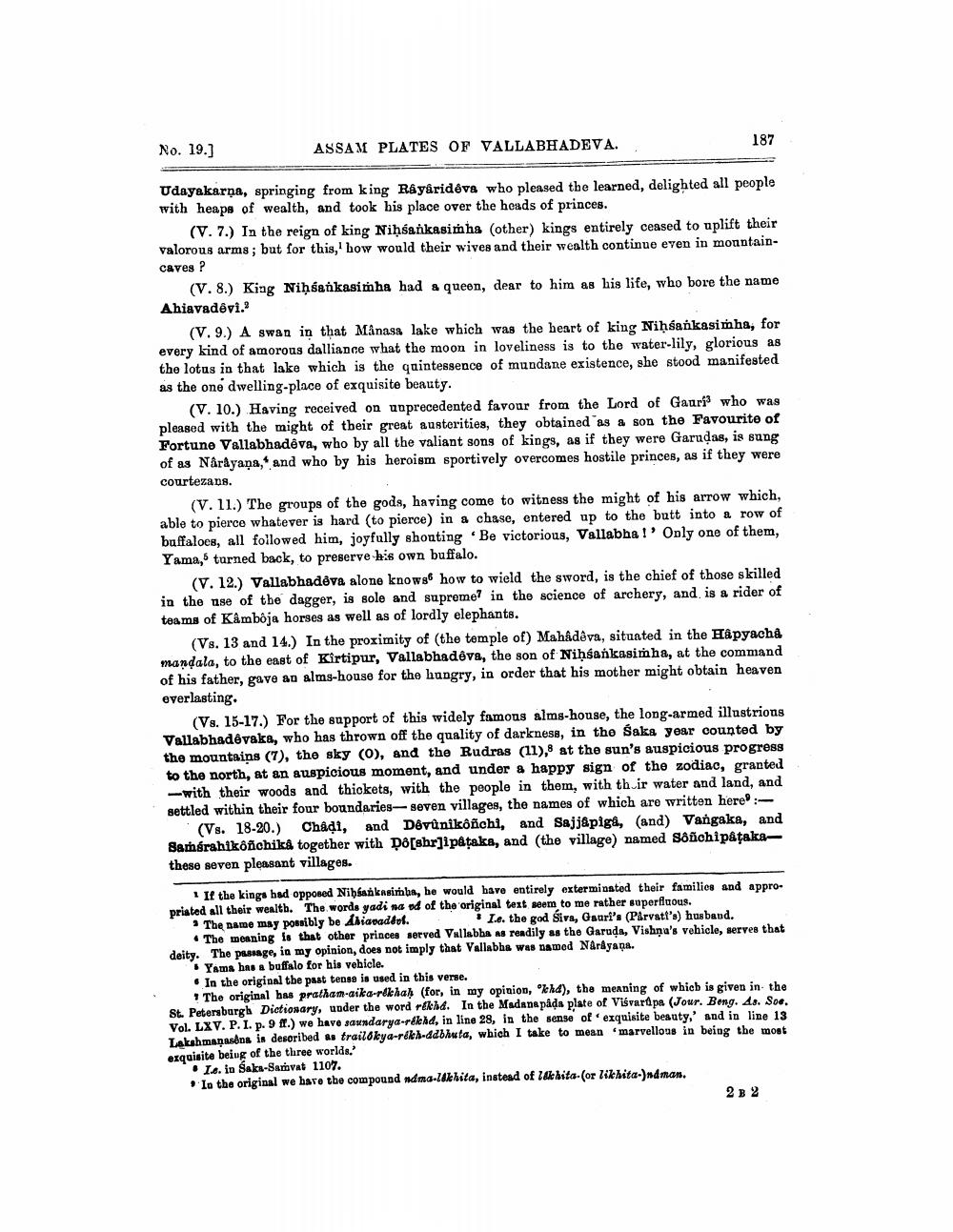________________
No. 19.)
ASSAM PLATES OF VALLABHADEVA.
187
Udayakarņa, springing from king Râyâridevs who pleased the learned, delighted all people with heaps of wealth, and took his place over the heads of princes.
(V. 7.) In the reign of king Nihsankasimha (other) kings entirely ceased to uplift their valorous arms; but for this,' how would their wives and their wealth continue even in mountaincaves ?
(V. 8.) King Niušankasimha had a queen, dear to him as his life, who bore the name Ahiavadêvi.
(V.9.) A swan in that Manasa lake which was the heart of king Niḥsankasimha, for every kind of amorous dalliance what the moon in loveliness is to the water-lily, glorious as the lotus in that lake which is the quintessence of mundane existence, she stood manifested as the one dwelling-place of exquisite beauty.
(V. 10.) Having received on unprecedented favour from the Lord of Gauri who was pleased with the might of their great austerities, they obtained as a son the Favourite of Fortune Vallabhadeva, who by all the valiant sons of kings, as if they were Garudas, is sung of as Narayana,' and who by his heroism sportively overcomes hostile princes, as if they were courtezans.
(V. 11.) The groups of the gods, having come to witness the might of his arrow which, able to pierce whatever is hard to pierce) in a chase, entered up to the butt into a row of buffaloes, all followed him, joyfully shouting Be victorious, Vallabha!' Only one of them, Yama, turned back, to preserve his own buffalo.
(V. 12.) Vallabhadeva alone knows how to wield the sword, is the chief of those skilled in the nse of the dagger, is sole and supreme? in the science of archery, and is a rider of teams of Kamboja horses as well as of lordly elephants.
(Vs. 13 and 14.) In the proximity of the temple of) Mahideva, situated in the Hâpyach! mandala, to the east of Kirtipur, Vallabhadeva, the son of Nihsankasimha, at the command of his father, gave an alms-house for the hungry, in order that his mother might obtain heaven everlasting
(Vs. 15-17.) For the support of this widely famous alms-house, the long-armed illustrions Vallabhadêyaka, who has thrown off the quality of darkness, in the Saka year counted by the mountains (T), the sky (0), and the Rudras (11), at the sun's auspicious progress to the north, at an auspicious moment, and under & happy sign of the zodiac, granted -with their woods and thickets, with the people in them, with thir water and land, and settled within their four boundaries-seven villages, the names of which are written here :
(Vs. 18-20.) Chadi, and Dôvůnikoñchi, and Sajj&piga, (and) Vangaka, and Samsrahikoñchika together with Do[sbr]ipataka, and (the village) named Soñchipatakathese seven pleasant villages.
If the kings had opposed Nihsankasimba, he would have entirely exterminated their families and appropriated all their wealth. The words yadi na od of the original text seem to me rather superfluous. The name may possibly be liavaddol.
I.e. the god siva, Gaari's (Parvatt's) husband. • The meaning is that other princes served Vulabba As readily as the Garuda, Vishna's vehicle, serves that deity. The passage, in my opinion, does not imply that Vallabhs was named Narayana.
Yams has a buffalo for his vehicle. • In the original the past tense is used in this verse.
The original has pratham-aika-rekhah (for, in my opinion, khd), the meaning of which is given in the St. Petersburgh Dictionary, under the word rekhd. In the Madanapada plate of Viśvardpa (Jour. Beng. As. Soe. Vol. LXV. P. I. p. 9 ff.) we have saundarya-rékeld, in line 28, in the sense of exquisite beauty,' and in line 13 Lakshmanas na is desoribed as trailblya-rékh-ddbhuta, which I take to mean marvellous in being the most exquisite being of the three worlds."
• Is. in Saks-Sauvat 1107. Io the original we have the compound ndma- hita, instead of ldk kita(or likhita-)ndman.
2 B 2




